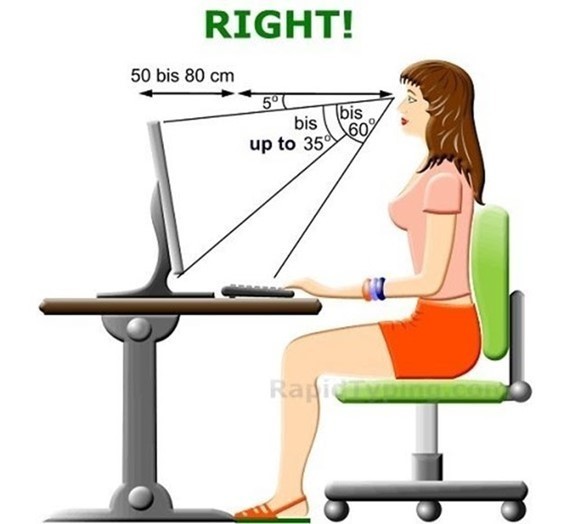
One of the most common questions that I receive from my patients is how to attain proper posture.
Patients often ask this because they work long hours at a desk, and they are beginning to notice low back pain, neck pain, or shoulder pain.
Going to work is becoming more of a nuisance, and the pain is starting to interfere with their daily life. They can't play with their kids, shovelling snow is a pain in the butt (literally), and they are getting frustrated.
Today you are going to learn 3 simple steps to improve your posture and reduce your risk of pain when sitting so that you can get back to enjoying your favourite activities!
What Is Posture?
First, we must understand what exactly posture is. In simple terms, posture is the relationship with the skeleton to the earth's gravitational forces. The skeleton is designed to disperse forces from the top of the head, through the feet and eventually to the floor.

With a totally "neutral" posture, the body is designed to disperse these forces with minimal impact on the surrounding tissues of the body.
But when the posture is altered in any way, that alters how the body perceives these forces. This leads to joints of the body taking on more force than they are designed to hold. This type of stress can lead to chronic diseases such as disc degeneration, osteoarthritis, chronic low back pain, sciatica, upper back and neck pain, and cervicogenic headaches, to name a few.
What is Perfect Posture?
First and foremost, I want to iterate that the best posture is the next posture. Movement is truly medicine.
However, considering the majority of our culture spends more than 40 hours per week in a seated position, seated ergonomics can be one of the most important topics that we can discuss.
Sitting, in general, is not a natural position, so there is no "perfect" position to sit. However, I understand that sitting for prolonged periods is unavoidable for some people.
Because sitting can be unavoidable, here are 3 simple steps to sit better and decrease your pain when sitting for prolonged periods of time!
3 Steps To Sit Better
1. Your Pelvis
The Problem: The most crucial adjustment you can make in a seated position is to sit correctly on your pelvis. Many people slouch in their chairs and roll forward. Slouching places a tremendous amount of pressure on the lower lumbar discs and the joints of our lower back.

The fix: Sit back in the chair and sit on the "sit bones" (ischial tuberosity) underneath the pelvis. This will promote a more neutral orientation of the pelvis, which supports the normal curvature of the lumbar spine and takes the pressure off of the lumbar discs. Products such as lumbar support cushions help you into this posture. Or you can take a small pillow and place it behind your chair to remind yourself not to slouch.

2. Knee Angle
The Problem: I often see people sitting with their feet folded under their chairs or spread out in front of them. Either of these positions places our pelvis and our hips in a position that makes it harder to gain the proper posture that we mentioned above.

The Fix: We want our feet directly under our knees at all times, which puts our knees at a nice 90-degree angle. Another thing you can do is keep your knees bent at 90 degrees and place a small stool underneath your feet to gain more flexion in the hip joint. Ideally, we want the knees higher than the hips; it takes a lot of pressure off of the low back whenever this is accomplished.
3. Shoulder and Head Positioning
The Problem: People often have to lean forward or look downward to see whatever they are working on, whether it is a book or a computer screen. This causes flexion of the neck and forward weight head posture.

The Fix: We want to make sure that our shoulders are rolled back into a neutral position, and our chin remains parallel to the floor. To accomplish the proper chin positioning, you may need to raise the computer screen about half of a foot off the desk. The optimal positioning of the computer monitor is to have the top of the monitor at eye level.
MOST IMPORTANTLY, KEEP MOVING!
Remember what I said earlier; there is nothing natural about a seated posture. Research has shown us that all it takes is a 20-second movement break every 30 minutes to have significant improvements on the health of your spine!
When we sit for more than 45 minutes, we place excess stress and pressure on the low back and allow blood to pool within the veins of our lower extremity.
Get up, stand, and walk around every 30-45 minutes to keep your blood flowing and allow all of the blood pooling in the veins in your legs to get recycled back into your heart. This will help you avoid developing blood clots throughout your legs and help to keep your joints moving correctly.
Motion is Lotion!
Are You Experiencing Low Back Pain or Neck Pain at Work?
Don't let the low back pain or neck pain you are experiencing at work prevent you from enjoying your favourite activities! Click HERE to book an appointment with E3 Chiropractic to get out of pain and get back to enjoying the activities you love!





